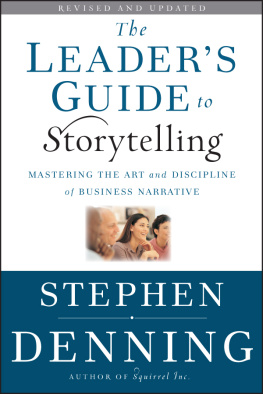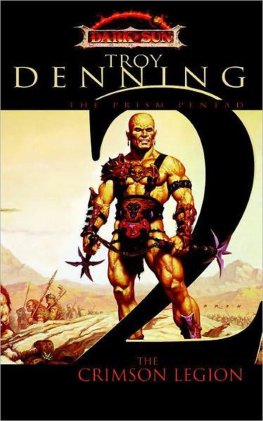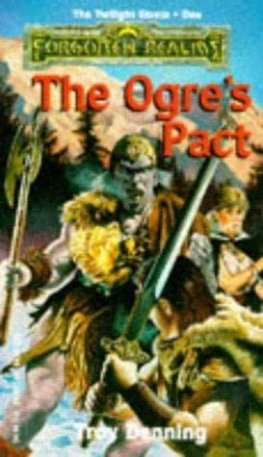Stephen Denning - The Leaders Guide to Storytelling
Here you can read online Stephen Denning - The Leaders Guide to Storytelling full text of the book (entire story) in english for free. Download pdf and epub, get meaning, cover and reviews about this ebook. year: 2011, publisher: Wiley, genre: Business. Description of the work, (preface) as well as reviews are available. Best literature library LitArk.com created for fans of good reading and offers a wide selection of genres:
Romance novel
Science fiction
Adventure
Detective
Science
History
Home and family
Prose
Art
Politics
Computer
Non-fiction
Religion
Business
Children
Humor
Choose a favorite category and find really read worthwhile books. Enjoy immersion in the world of imagination, feel the emotions of the characters or learn something new for yourself, make an fascinating discovery.
- Book:The Leaders Guide to Storytelling
- Author:
- Publisher:Wiley
- Genre:
- Year:2011
- Rating:4 / 5
- Favourites:Add to favourites
- Your mark:
- 80
- 1
- 2
- 3
- 4
- 5
The Leaders Guide to Storytelling: summary, description and annotation
We offer to read an annotation, description, summary or preface (depends on what the author of the book "The Leaders Guide to Storytelling" wrote himself). If you haven't found the necessary information about the book — write in the comments, we will try to find it.
The Leaders Guide to Storytelling — read online for free the complete book (whole text) full work
Below is the text of the book, divided by pages. System saving the place of the last page read, allows you to conveniently read the book "The Leaders Guide to Storytelling" online for free, without having to search again every time where you left off. Put a bookmark, and you can go to the page where you finished reading at any time.
Font size:
Interval:
Bookmark:

Copyright 2011 by John Wiley & Sons, Inc. All rights reserved.
Published by Jossey-Bass
A Wiley Imprint
989 Market Street, San Francisco, CA 94103-1741www.josseybass.com
No part of this publication may be reproduced, stored in a retrieval system, or transmitted in any form or by any means, electronic, mechanical, photocopying, recording, scanning, or otherwise, except as permitted under Section 107 or 108 of the 1976 United States Copyright Act, without either the prior written permission of the publisher, or authorization through payment of the appropriate per-copy fee to the Copyright Clearance Center, Inc., 222 Rosewood Drive, Danvers, MA 01923, 978-750-8400, fax 978-646-8600, or on the Web at www.copyright.com. Requests to the publisher for permission should be addressed to the Permissions Department, John Wiley & Sons, Inc., 111 River Street, Hoboken, NJ 07030, 201-748-6011, fax 201-748-6008, or online at www.wiley.com/go/permissions.
Permission credit lines are printed on pages 347348.
Readers should be aware that Internet Web sites offered as citations and/or sources for further information may have changed or disappeared between the time this was written and when it is read.
Limit of Liability/Disclaimer of Warranty: While the publisher and author have used their best efforts in preparing this book, they make no representations or warranties with respect to the accuracy or completeness of the contents of this book and specifically disclaim any implied warranties of merchantability or fitness for a particular purpose. No warranty may be created or extended by sales representatives or written sales materials. The advice and strategies contained herein may not be suitable for your situation. You should consult with a professional where appropriate. Neither the publisher nor author shall be liable for any loss of profit or any other commercial damages, including but not limited to special, incidental, consequential, or other damages.
Jossey-Bass books and products are available through most bookstores. To contact Jossey-Bass directly call our Customer Care Department within the U.S. at 800-956-7739, outside the U.S. at 317-572-3986, or fax 317-572-4002.
Jossey-Bass also publishes its books in a variety of electronic formats. Some content that appears in print may not be available in electronic books.
Library of Congress Cataloging-in-Publication Data
Denning, Stephen, 1944
The Leader's Guide to Storytelling : Mastering the Art and Discipline of Business Narrative / Stephen Denning.Revised and updated edition.
p. cm
Includes bibliographical references and index.
ISBN 978-0-470-54867-7 (cloth); ISBN 978-1-118-00876-8 (ebk); ISBN 978-1-118-00877-5 (ebk); ISBN 978-1-118-00878-2 (ebk)
1. Communication in management. 2. Public speaking. 3. Business communication. 4. Communication in organizations. I. Title.
HD30.3.D457 2011
658.45dc22
2010048700
Preface
Much has happened in the five years since the first edition of this book provided the basic building blocks of leadership storytelling.
Since the first edition, the importance of storytelling as a leadership tool has become generally accepted, even in big organizations. The days are gone when I would be recruited by a nervous executive to hold a storytelling workshop for a major corporation with a euphemistic label like strategic change management. Now executives tell me, Let's call it what it is: storytelling!
This reflects the fact that storytelling has gained recognition as a core competence of leadership. It is now standard practice to include a section on storytelling in books on leadership and change management, such as A Whole New Mind (2006) by Dan Pink, The Leadership Challenge (2008) by Jim Kouzes and Barry Posner, Made to Stick (2008) by Chip Heath and Dan Heath, and Getting Change Right (2010) by Seth Kahan.
The concept of leadership has itself also evolved. Chapter Twelve of the first edition of this book argued that storytelling is more than simply a communication tool and implied the emergence of a different kind of leadersomeone who engages in interactive conversations rather than merely telling people what to do. It suggested that storytelling goes beyond the use of individual stories for specific purposes and implied a different way of thinking, speaking, and acting in the workplace.
I developed these ideas further in my book The Secret Language of Leadership: How Leaders Inspire Action Through Narrative (2007), which examined what this different way of thinking, speaking, and acting entailed. It explored in more detail how storytelling tools could be deployed to meet the specific challenges of leadership. It showed how the leadership communication triad, get attentionstimulate desire for changereinforce with reasons, could be used as a template to deal with virtually any leadership challenge. Chapter Two of this edition has been updated to reflect these discoveries.
Since 2005, a massive rethinking of management itself has also gotten under way. In 2009, the Shift Index quantified with startling clarity the long-term decline of management: the rate of return on assets of U.S. firms is now only a quarter of what it was in 1965; the life expectancy of a firm in the Fortune 500 has declined to less than fifteen years and heading toward five years unless something changes; executive turnover is accelerating; only one in five workers is fully engaged in his or her work
The standard practices of management are increasingly seen as anachronistic. Tomorrow's business imperatives, Gary Hamel wrote in Harvard Business Review in 2009, lie outside the performance envelope of today's bureaucracy-infused management practices Equipping organizations to tackle the future would require a management revolution no less momentous than the one that spawned modern industry.
Chapter Eleven of the first edition of this book began to explore through the lens of disruptive innovation what this management revolution might involve. I argued that leadership storytelling is part of the answer. Since then, I have come to see more clearly what management actions in addition to storytelling are needed to create an organization that promotes continuous innovation on a sustained basis. In effect, storytelling is not just a core competence of leadership: it is also central component of management itself. My new book, The Leader's Guide to Radical Management: Reinventing the Workplace for the Twenty-First Century (2010), spells this out in more detail, and Chapter Eleven of this book has been updated to reflect these insights.
This book thus provides the building blocks of storytelling for two of my other books. The Secret Language of Leadership (2007) shows how storytelling is a central component of leadership. The Leader's Guide to Radical Management (2010) shows how storytelling is a core competence of management itself.
The importance of storytelling in branding and marketing has also been reinforced by the explosion of social media. In 2005, when the first edition of this book was published, Facebook and YouTube had just been created, and Twitter did not exist. Today these three Web sites have hundreds of millions of participants, who are telling stories about their lives and the products and services that they use. This phenomenon has had a dramatic impact on practices in branding and marketing, as the ongoing shift in power from seller to buyer has dramatically accelerated. Understanding and mastering the elements of interactive storytelling in this sphere has become even more important than before. Chapter Five of this edition has been updated to incorporate the implications of these developments.
Font size:
Interval:
Bookmark:
Similar books «The Leaders Guide to Storytelling»
Look at similar books to The Leaders Guide to Storytelling. We have selected literature similar in name and meaning in the hope of providing readers with more options to find new, interesting, not yet read works.
Discussion, reviews of the book The Leaders Guide to Storytelling and just readers' own opinions. Leave your comments, write what you think about the work, its meaning or the main characters. Specify what exactly you liked and what you didn't like, and why you think so.











